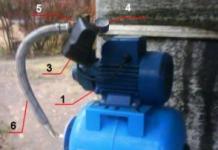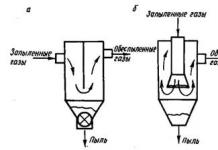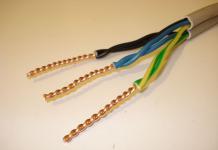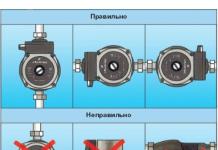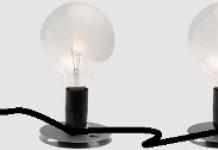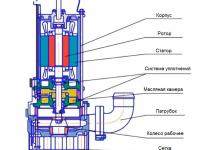When several power receivers are simultaneously connected to the same network, these receivers can easily be considered simply as elements of a single circuit, each of which has its own resistance.
In some cases, this approach turns out to be quite acceptable: incandescent lamps, electric heaters, etc. can be perceived as resistors. That is, the devices can be replaced with their resistances, and it is easy to calculate the circuit parameters.
The method of connecting power receivers can be one of the following: serial, parallel or mixed type of connection.
Serial connection

When several receivers (resistors) are connected in a series circuit, that is, the second terminal of the first is connected to the first terminal of the second, the second terminal of the second is connected to the first terminal of the third, the second terminal of the third is connected to the first terminal of the fourth, etc., then when such a circuit is connected to power source, a current I of the same magnitude will flow through all elements of the circuit. This idea is illustrated by the following figure.

Having replaced the devices with their resistances, we convert the drawing into a circuit, then resistances R1 to R4, connected in series, will each take on certain voltages, which in total will give the value of the EMF at the terminals of the power source. For simplicity, hereinafter we will depict the source in the form of a galvanic element.
Having expressed the voltage drops through current and through resistance, we obtain an expression for the equivalent resistance of a series circuit of receivers: the total resistance of a series connection of resistors is always equal to the algebraic sum of all resistances that make up this circuit. And since the voltages on each section of the circuit can be found from Ohm’s law (U = I*R, U1 = I*R1, U2 = I*R2, etc.) and E = U, then for our circuit we get:
The voltage across the power supply terminals is equal to the sum of the voltage drops across each of the series-connected receivers that make up the circuit.
Since the current flows through the entire circuit of the same value, it is fair to say that the voltages on series-connected receivers (resistors) are related to each other in proportion to the resistances. And the higher the resistance, the higher the voltage applied to the receiver will be.
For a series connection of n resistors with the same resistance Rk, the equivalent total resistance of the entire circuit will be n times greater than each of these resistances: R = n*Rk. Accordingly, the voltages applied to each of the resistors in the circuit will be equal to each other, and will be n times less than the voltage applied to the entire circuit: Uk = U/n.

The series connection of power receivers is characterized by the following properties: if you change the resistance of one of the receivers in the circuit, the voltages at the remaining receivers in the circuit will change; if one of the receivers breaks, the current will stop in the entire circuit, in all other receivers.
Due to these features, serial connection is rare, and it is used only where the network voltage is higher than the rated voltage of the receivers, in the absence of alternatives.
For example, with a voltage of 220 volts you can power two series-connected lamps of equal power, each of which is designed for a voltage of 110 volts. If these lamps have different rated power at the same rated supply voltage, then one of them will be overloaded and most likely will burn out instantly.
Parallel connection

Parallel connection of receivers involves connecting each of them between a pair of points in an electrical circuit so that they form parallel branches, each of which is powered by source voltage. For clarity, let us again replace the receivers with their electrical resistances in order to obtain a diagram that is convenient for calculating parameters.

As already mentioned, in the case of a parallel connection, each of the resistors experiences the same voltage. And in accordance with Ohm’s law we have: I1=U/R1, I2=U/R2, I3=U/R3.
Here I is the source current. Kirchhoff's first law for a given circuit allows us to write down an expression for the current in its unbranched part: I = I1+I2+I3.
Hence, the total resistance for parallel connection of circuit elements can be found from the formula:
The reciprocal of resistance is called conductivity G, and the formula for the conductivity of a circuit consisting of several parallel-connected elements can also be written: G = G1 + G2 + G3. The conductivity of a circuit in the case of a parallel connection of the resistors forming it is equal to the algebraic sum of the conductivities of these resistors. Consequently, when parallel receivers (resistors) are added to the circuit, the total resistance of the circuit will decrease, and the total conductivity will correspondingly increase.
Currents in a circuit consisting of parallel-connected receivers are distributed between them in direct proportion to their conductivities, that is, inversely proportional to their resistances. Here we can give an analogy from hydraulics, where the flow of water is distributed through pipes in accordance with their cross-sections, then a larger cross-section is similar to less resistance, that is, greater conductivity.
If a circuit consists of several (n) identical resistors connected in parallel, then the total resistance of the circuit will be n times lower than the resistance of one of the resistors, and the current through each of the resistors will be n times less than the total current: R = R1/ n; I1 = I/n.
A circuit consisting of parallel-connected receivers connected to a power source is characterized in that each of the receivers is energized by the power source.
For an ideal source of electricity, the following statement is true: when resistors are connected or disconnected in parallel with the source, the currents in the remaining connected resistors will not change, that is, if one or more receivers in the parallel circuit fail, the rest will continue to operate in the same mode.
Due to these features, a parallel connection has a significant advantage over a serial connection, and for this reason it is the parallel connection that is most common in electrical networks. For example, all electrical appliances in our homes are designed for parallel connection to the household network, and if you turn off one, it will not harm the rest at all.

Comparison of series and parallel circuits
By mixed connection of receivers we mean such a connection when part or several of them are connected to each other in series, and the other part or several are connected in parallel. In this case, the entire chain can be formed from different connections of such parts with each other. For example, consider the diagram:

Three series-connected resistors are connected to the power source, two more are connected in parallel to one of them, and the third is connected in parallel to the entire circuit. To find the total resistance of the circuit, they go through successive transformations: a complex circuit is sequentially reduced to a simple form, sequentially calculating the resistance of each link, and so the total equivalent resistance is found.

For our example. First, find the total resistance of two resistors R4 and R5 connected in series, then the resistance of their parallel connection with R2, then add R1 and R3 to the resulting value, and then calculate the resistance value of the entire circuit, including the parallel branch R6.
Various methods of connecting power receivers are used in practice for various purposes in order to solve specific problems. For example, a mixed connection can be found in smooth charging circuits in powerful power supplies, where the load (capacitors after the diode bridge) first receives power in series through a resistor, then the resistor is shunted by relay contacts, and the load is connected to the diode bridge in parallel.
Andrey Povny
The current in the circuit flows through the conductors to the load from the source. Copper is most often used as such elements. A circuit may have several electrical receivers. Their resistances vary. In an electrical circuit, conductors can be connected in parallel or in series. There are also mixed types. The difference between each of them should be known before choosing the electrical circuit structure.
Conductors and circuit elements
Current flows through conductors. It follows from the source to the load. In this case, the conductor must easily release electrons.
A conductor that has resistance is called a resistor. The voltage of this element is the potential difference between the ends of the resistor, which is consistent with the direction of power flow.
The serial and parallel connection of conductors is characterized by one general principle. Current flows in the circuit from plus (it is called the source) to minus, where the potential becomes less and less. In electrical diagrams, the resistance of the wires is considered to be zero, since it is negligibly small.
Therefore, when calculating a serial or parallel connection, they resort to idealization. This makes them easier to learn. In real circuits, the potential gradually decreases as it moves along the wire and elements that have a parallel or series connection.
Series connection of conductors

If there is a series combination of conductors, the resistances are turned on one after another. In this position, the current strength in all elements of the circuit is the same. Series-connected conductors create a voltage in the area that is equal to their sum on all elements.
Charges do not have the opportunity to accumulate at the nodes of the circuit. This would lead to a change in the electric field voltage and current.
In the presence of constant voltage, the current will depend on the resistance of the circuit. Therefore, with a series connection, the resistance will change due to a change in one load.
Series connection of conductors has a disadvantage. If one of the circuit elements breaks down, the operation of all its other components will be interrupted. For example, as in a garland. If one light bulb burns out, the entire product will not work.
If the conductors were connected in series in a circuit, their resistance at each point will be the same. The resistance in the sum of all circuit elements will be equal to the sum of the voltage reduction in the circuit sections.

Experience can confirm this. The series connection of resistances is calculated using instruments and mathematical verification. For example, three constant resistances of known magnitude are taken. They are connected in series and connected to a 60 V power supply.
After this, the expected indicators of the devices are calculated if the circuit is closed. According to Ohm's law, there is a current in the circuit, which will allow us to determine the voltage drop in all its sections. After this, the results obtained are summed up and the total value of the reduction in resistance in the external circuit is obtained. The series connection of resistances can be confirmed approximately. If we do not take into account the internal resistance created by the energy source, the voltage drop will be less than the sum of the resistances. Using instruments, you can verify that equality is approximately maintained.
Parallel connection of conductors
When connecting conductors in series and parallel in a circuit, resistors are used. A parallel connection of conductors is a system in which some ends of all resistors converge into one common node, and the other ends into another node. More than two conductors converge at these points in the circuit.

With this connection, the same voltage is applied to the elements. Parallel sections of a chain are called branches. They pass between two nodes. Parallel and serial connections have their own properties.
If there are branches in the electrical circuit, then the voltage on each of them will be the same. It is equal to the voltage on the unbranched section. At this point, the current strength will be calculated as the sum of it in each branch.
A value equal to the sum of the inverses of the resistances of the branches will also be the inverse of the resistance of the parallel connection section.
Parallel connection of resistances
Parallel and series connections differ in the calculation of the resistance of its elements. When connected in parallel, the current branches out. This increases the conductivity of the circuit (reduces the total resistance), which will be equal to the sum of the conductances of the branches.
If several resistors of the same value are connected in parallel, then the total resistance of the circuit will be less than one resistor as many times as they are included in the circuit.
Serial and parallel connection of conductors have a number of features. In a parallel connection, the current is inversely proportional to the resistance. The currents in resistors do not depend on each other. Therefore, turning off one of them will not affect the operation of the others. Therefore, many electrical appliances have this type of connection of circuit elements.
Mixed
Parallel and series connections of conductors can be combined in the same circuit. For example, elements connected in parallel can be connected in series with another resistor or group of resistors. This is a mixed compound. The total resistance of the circuits is calculated by separately summing the values for the parallel connected unit and for the series connection.

Moreover, the equivalent resistances of series-connected elements are first calculated, and then the total resistance of parallel sections of the circuit is calculated. Serial connection in calculations takes priority. These types of electrical circuits are quite common in various devices and equipment.
Having familiarized yourself with the types of connections of circuit elements, you can understand the principle of organization of circuits of various electrical devices. Parallel and serial connections have a number of features in the calculation and operation of the entire system. Knowing them, you can correctly use each of the presented types to connect elements of electrical circuits.
Usually everyone finds it difficult to answer. But this riddle, when applied to electricity, is solved quite definitely.
Electricity begins with Ohm's law.
And if we consider the dilemma in the context of parallel or serial connections - considering one connection to be a chicken and the other to be an egg, then there is no doubt at all.
Because Ohm's law is the very original electrical circuit. And it can only be consistent.
Yes, they came up with a galvanic cell and didn’t know what to do with it, so they immediately came up with another light bulb. And this is what came out of it. Here, a voltage of 1.5 V immediately flowed as current, in strict compliance with Ohm's law, through the light bulb to the back of the same battery. And inside the battery itself, under the influence of the sorceress-chemistry, the charges again ended up at the original point of their journey. And therefore, where the voltage was 1.5 volts, it remains that way. That is, the voltage is always the same, and the charges are constantly moving and successively pass through the light bulb and the galvanic cell.
And it is usually drawn on the diagram like this:

According to Ohm's law I=U/R
Then the resistance of the light bulb (with the current and voltage that I wrote) will be
R= 1/U, WhereR = 1 Ohm
And the power will be released P = I * U , that is, P=2.25 Vm
In a series circuit, especially with such a simple and undeniable example, it is clear that the current that runs through it from beginning to end is the same all the time. And if we now take two light bulbs and make sure that the current runs first through one and then through the other, then the same thing will happen again - the current will be the same in both the light bulb and the other. Although different in size. The current now experiences the resistance of two light bulbs, but each of them has the same resistance as it was, and remains the same, because it is determined solely by the physical properties of the light bulb itself. We calculate the new current again using Ohm's law.

It will turn out to be equal to I=U/R+R, that is, 0.75A, exactly half of the current that was at first.
In this case, the current has to overcome two resistances, it becomes smaller. As can be seen from the glow of the light bulbs - they are now burning at full intensity. And the total resistance of a chain of two light bulbs will be equal to the sum of their resistances. Knowing arithmetic, in a particular case you can use the action of multiplication: if N identical light bulbs are connected in series, then their total resistance will be equal to N multiplied by R, where R is the resistance of one light bulb. The logic is impeccable.

And we will continue our experiments. Now let's do something similar to what we did with light bulbs, but only on the left side of the circuit: add another galvanic element, exactly the same as the first. As you can see, now our total voltage has doubled, and the current has returned to 1.5 A, which is signaled by the light bulbs, which light up again at full power.
We conclude:
- When an electrical circuit is connected in series, the resistances and voltages of its elements are summed up, and the current on all elements remains unchanged.
It is easy to verify that this statement is true for both active components (galvanic cells) and passive ones (light bulbs, resistors).
That is, this means that the voltage measured across one resistor (it is called the voltage drop) can be safely summed up with the voltage measured across another resistor, and the total will be the same 3 V. And at each of the resistances it will be equal to half - then there is 1.5 V. And this is fair. Two galvanic cells produce their voltages, and two light bulbs consume them. Because in a voltage source, the energy of chemical processes is converted into electricity, which takes the form of voltage, and in light bulbs the same energy is converted from electrical into heat and light.
Let's return to the first circuit, connect another light bulb in it, but differently.
Now the voltage at the points connecting the two branches is the same as on the galvanic element - 1.5 V. But since the resistance of both bulbs is also the same as it was, the current through each of them will flow 1.5 A - "full glow" current.

The galvanic cell now supplies them with current at the same time, therefore, both of these currents flow out of it at once. That is, the total current from the voltage source will be 1.5 A + 1.5 A = 3.0 A.
What is the difference between this circuit and the circuit when the same light bulbs were connected in series? Only in the glow of light bulbs, that is, only in current.
Then the current was 0.75 A, but now it is immediately 3 A.
It turns out that if we compare it with the original circuit, then when connecting the light bulbs in series (scheme 2), there was more resistance to the current (which is why it decreased, and the light bulbs lost their luminosity), and a parallel connection has LESS resistance, although the resistance of the light bulbs remained unchanged. What's the matter?
But the fact is that we forget one interesting truth, that every sword is a double-edged sword.
When we say that a resistor resists current, we seem to forget that it still conducts current. And now that the light bulbs have been connected in parallel, their overall ability to conduct current rather than resist it has increased. Well, and, accordingly, a certain amount G, by analogy with resistance R and should be called conductivity. And it must be summed up in a parallel connection of conductors.
Well here she is
Ohm's law will then look like
I = U* G&
And in the case of a parallel connection, the current I will be equal to U*(G+G) = 2*U*G, which is exactly what we observe.
Replacement of circuit elements with a common equivalent element
Engineers often need to recognize currents and voltages in all parts of circuits. But real electrical circuits can be quite complex and branched and can contain many elements that actively consume electricity and are connected to each other in completely different combinations. This is called electrical circuit calculation. It is done when designing the energy supply of houses, apartments, and organizations. In this case, it is very important what currents and voltages will act in the electrical circuit, if only in order to select appropriate wire sections, loads on the entire network or its parts, and so on. And I think everyone understands how complex electronic circuits are, containing thousands or even millions of elements.
The very first thing that suggests itself is to use the knowledge of how voltage currents behave in such simple network connections as serial and parallel. They do this: instead of a serial connection found on the network of two or more active consumer devices (like our light bulbs), draw one, but so that its resistance is the same as both. Then the picture of currents and voltages in the rest of the circuit will not change. Similarly with parallel connections: instead of them, draw an element whose CONDUCTIVITY would be the same as both.
Now, if we redraw the circuit, replacing the serial and parallel connections with one element, we will get a circuit called an “equivalent equivalent circuit.”
This procedure can be continued until we are left with the simplest one - with which we illustrated Ohm’s law at the very beginning. Only instead of the light bulb there will be one resistance, which is called the equivalent load resistance.
This is the first task. It allows us to use Ohm's law to calculate the total current in the entire network, or the total load current.
This is a complete calculation of the electrical network.
Examples
Let the circuit contain 9 active resistances. It could be light bulbs or something else.
A voltage of 60 V is applied to its input terminals.

The resistance values for all elements are as follows:
Find all unknown currents and voltages.
It is necessary to follow the path of searching for parallel and serial sections of the network, calculating their equivalent resistances and gradually simplifying the circuit. We see that R 3, R 9 and R 6 are connected in series. Then their equivalent resistance R e 3, 6, 9 will be equal to their sum R e 3, 6, 9 = 1 + 4 + 1 Ohm = 6 Ohm.

Now we replace the parallel piece of resistance R 8 and R e 3, 6, 9, getting R e 8, 3, 6, 9. Only when connecting conductors in parallel will the conductivity have to be added.
Conductivity is measured in units called siemens, the reciprocal of ohms.
If we turn the fraction over, we get resistance R e 8, 3, 6, 9 = 2 Ohm
Exactly the same as in the first case, we combine resistances R 2, R e 8, 3, 6, 9 and R 5 connected in series, obtaining R e 2, 8, 3, 6, 9, 5 = 1 + 2 + 1 = 4 Ohm.
There are two steps left: obtain a resistance equivalent to two resistors for parallel connection of conductors R 7 and R e 2, 8, 3, 6, 9, 5.
It is equal to R e 7, 2, 8, 3, 6, 9, 5 = 1/(1/4+1/4)=1/(2/4)=4/2 = 2 Ohm

At the last step, we sum up all series-connected resistances R 1, R e 7, 2, 8, 3, 6, 9, 5 and R 4 and obtain a resistance equivalent to the resistance of the entire circuit R e and equal to the sum of these three resistances
R e = R 1 + R e 7, 2, 8, 3, 6, 9, 5 + R4 = 1 + 2 + 1 = 4 Ohm
Well, let’s remember in whose honor the unit of resistance we wrote in the last of these formulas was named, and use his law to calculate the total current in the entire circuit I
![]()

Now, moving in the opposite direction, towards increasing complexity of the network, we can obtain currents and voltages in all chains of our fairly simple circuit according to Ohm’s law.
This is how apartment power supply schemes are usually calculated, which consist of parallel and serial sections. Which, as a rule, is not suitable in electronics, because a lot of things work there differently, and everything is much more intricate. And such a circuit, for example, when you don’t understand whether the connection of conductors is parallel or serial, is calculated according to Kirchhoff’s laws.

Parallel and series connection of conductors are methods of switching an electrical circuit. Electrical circuits of any complexity can be represented using these abstractions.
Definitions
There are two ways to connect conductors; it becomes possible to simplify the calculation of a circuit of arbitrary complexity:
- The end of the previous conductor is connected directly to the beginning of the next one - the connection is called serial. A chain is formed. To turn on the next link, you need to break the electrical circuit by inserting a new conductor there.
- The beginnings of the conductors are connected by one point, the ends by another, the connection is called parallel. A ligament is usually called a branch. Each individual conductor forms a branch. Common points are called electrical network nodes.
In practice, a mixed connection of conductors is more common, some are connected in series, some in parallel. You need to break the chain into simple segments and solve the problem for each separately. An arbitrarily complex electrical circuit can be described by a parallel, series connection of conductors. This is how it is done in practice.
Using parallel and series connection of conductors
Terms applied to electrical circuits
Theory serves as the basis for the formation of solid knowledge; few people know how voltage (potential difference) differs from voltage drop. In physics terms, the internal circuit is the current source; the one located outside is called the external circuit. The demarcation helps to correctly describe the distribution of the field. The current does work. In the simplest case, heat generation follows the Joule-Lenz law. Charged particles, moving towards a lower potential, collide with the crystal lattice and release energy. The resistances heat up.
To ensure movement, it is necessary to maintain a potential difference at the ends of the conductor. This is called circuit section voltage. If you simply place a conductor in a field along the power lines, the current will flow and will be very short-lived. The process will end with the onset of equilibrium. The external field will be balanced by the own field of charges, in the opposite direction. The current will stop. For the process to become continuous, an external force is needed.
The current source acts as such a drive for the movement of the electrical circuit. To maintain potential, work is done inside. Chemical reaction, as in a galvanic cell, mechanical forces - a hydroelectric power station generator. The charges inside the source move in the direction opposite to the field. The work of outside forces is being done on this. You can paraphrase the above formulations and say:
- The outer part of the circuit, where the charges move, carried away by the field.
- The interior of a circuit where charges move against the voltage.
The generator (current source) is equipped with two poles. The one with less potential is called negative, the other is called positive. In the case of alternating current, the poles continuously change places. The direction of movement of charges is not constant. Current flows from the positive pole to the negative pole. The movement of positive charges goes in the direction of decreasing potential. According to this fact, the concept of potential drop is introduced:
The potential drop of a section of a circuit is the decrease in potential within the section. Formally, this is tension. For branches of a parallel circuit it is the same.
Voltage drop also means something else. The value characterizing heat losses is numerically equal to the product of the current and the active resistance of the section. Ohm's and Kirchhoff's laws, discussed below, are formulated for this case. In electric motors and transformers, the potential difference can differ significantly from the voltage drop. The latter characterizes losses in active resistance, while the former takes into account the full operation of the current source.
When solving physical problems, for simplification, the motor can include an EMF, the direction of action of which is opposite to the effect of the power source. The fact of energy loss through the reactive part of the impedance is taken into account. School and university physics courses are distinguished by their isolation from reality. That is why students listen with open mouths about the phenomena taking place in electrical engineering. In the period preceding the era of the industrial revolution, the main laws were discovered; a scientist must combine the role of a theorist and a talented experimenter. The prefaces to Kirchhoff's works openly speak about this (Georg Ohm's works have not been translated into Russian). The teachers literally attracted people with additional lectures, flavored with visual, amazing experiments.

Ohm's and Kirchhoff's laws as applied to series and parallel connection of conductors
Ohm's and Kirchhoff's laws are used to solve real problems. The first deduced equality purely empirically - experimentally - the second began with a mathematical analysis of the problem, then tested his guesses with practice. Here is some information to help solve the problem:

Calculate the resistance of elements in series and parallel connection
The algorithm for calculating real circuits is simple. Here are some points regarding the topic under consideration:
- When connected in series, the resistances are summed up; when connected in parallel, the conductivities are summed up:
- For resistors, the law is rewritten in unchanged form. With a parallel connection, the final resistance is equal to the product of the original ones divided by the total amount. In case of sequential, the denominations are summed up.
- Inductance acts as reactance (j*ω*L) and behaves like a regular resistor. In terms of writing the formula, it is no different. The nuance, for any purely imaginary impedance, is that you need to multiply the result by the operator j, the circular frequency ω (2*Pi*f). When the inductors are connected in series, the values are summed up; when inductors are connected in parallel, the reciprocal values are added up.
- The imaginary resistance of the capacitance is written as: -j/ω*С. It’s easy to notice: adding up the values of a series connection, we get a formula exactly as it was for resistors and inductances in a parallel connection. For capacitors the opposite is true. When connected in parallel, the values are added; when connected in series, the reciprocal values are added.
The theses can easily be extended to arbitrary cases. The voltage drop across two open silicon diodes is equal to the sum. In practice it is 1 volt, the exact value depends on the type of semiconductor element and characteristics. Power supplies are considered in a similar way: when connected in series, the ratings are added up. Parallel is often found in substations where transformers are placed side by side. The voltage will be the same (controlled by equipment), divided between the branches. The transformation coefficient is strictly equal, blocking the occurrence of negative effects.
Some people find it difficult: two batteries of different ratings are connected in parallel. The case is described by Kirchhoff's second law; physics cannot imagine any complexity. If the ratings of two sources are unequal, the arithmetic mean is taken, if the internal resistance of both is neglected. Otherwise, the Kirchhoff equations are solved for all contours. The unknown currents will be (three in total), the total number of which is equal to the number of equations. For complete understanding, a drawing has been provided.

An example of solving Kirchhoff's equations
Let's look at the image: according to the conditions of the problem, source E1 is stronger than E2. We take the direction of the currents in the circuit from common sense. But if they had entered it incorrectly, after solving the problem, one would have turned out with a negative sign. Then it was necessary to change direction. Obviously, current flows in the external circuit as shown in the figure. We compose the Kirchhoff equations for three circuits, this is what follows:
- The work of the first (strong) source is spent on creating a current in the external circuit, overcoming the weakness of the neighbor (current I2).
- The second source does not perform useful work on the load and fights with the first. There is no other way to say it.
Connecting batteries of different ratings in parallel is certainly harmful. What is observed at a substation when using transformers with different transmission ratios. Equalizing currents do no useful work. Different batteries connected in parallel will begin to function effectively when the strong one drops to the level of the weak one.
Elements of an electrical circuit can be connected in two ways. A series connection involves connecting elements to each other, and in a parallel connection, the elements are part of parallel branches. The way the resistors are connected determines the method for calculating the total resistance of the circuit.
Steps
Serial connection
- For example, a series circuit consists of three resistors with resistances of 2 ohms, 5 ohms and 7 ohms. Total circuit resistance: 2 + 5 + 7 = 14 ohms.
-
If the resistance of each element of the circuit is not known, use Ohm's law: V = IR, where V is voltage, I is current, R is resistance. First find the current and total voltage.
Substitute the known values into the formula describing Ohm's law. Rewrite the formula V = IR to isolate the resistance: R = V/I. Plug the known values into this formula to calculate the total resistance.
- For example, the voltage of the current source is 12 V and the current is 8 A. The total resistance of the series circuit is: R O = 12 V / 8 A = 1.5 ohms.
Determine if the circuit is in series. A serial connection is a single circuit without any branches. Resistors or other elements are located one behind the other.
Add up the resistances of the individual elements. The resistance of a series circuit is equal to the sum of the resistances of all elements included in this circuit. The current strength in any part of the series circuit is the same, so the resistances simply add up.
Parallel connection
-
Determine whether the circuit is parallel. A parallel chain branches at some point into several branches, which are then connected again. Current flows through each branch of the circuit.
Calculate the total resistance based on the resistance of each branch. Each resistor reduces the amount of current flowing through one leg, so it has little effect on the overall resistance of the circuit. Formula for calculating the total resistance: where R 1 is the resistance of the first branch, R 2 is the resistance of the second branch and so on until the last branch R n.
Calculate the resistance from the known current and voltage. Do this if the resistance of each circuit element is not known.
Substitute the known values into the Ohm's law formula. If the total current and voltage in the circuit are known, the total resistance is calculated using Ohm's law: R = V/I.
- For example, the voltage in a parallel circuit is 9 V and the total current is 3 A. Total resistance: R O = 9 V / 3 A = 3 ohms.
-
Look for branches with zero resistance. If a branch of a parallel circuit has no resistance at all, then all the current will flow through that branch. In this case, the total resistance of the circuit is 0 ohms.
Combined connection
- For example, a circuit includes a resistor whose resistance is 1 ohm and a resistor whose resistance is 1.5 ohms. Behind the second resistor, the circuit branches into two parallel branches - one branch includes a resistor with a resistance of 5 Ohms, and the second with a resistance of 3 Ohms. Trace two parallel branches to highlight them on the circuit diagram.
-
Find the resistance of the parallel circuit. To do this, use the formula to calculate the total resistance of a parallel circuit: 1 R O = 1 R 1 + 1 R 2 + 1 R 3 + . . . 1 R n (\displaystyle (\frac (1)(R_(O)))=(\frac (1)(R_(1)))+(\frac (1)(R_(2)))+(\ frac (1)(R_(3)))+...(\frac (1)(R_(n)))).
Simplify the chain. Once you have found the total resistance of the parallel circuit, you can replace it with one element whose resistance is equal to the calculated value.
- In our example, get rid of the two parallel legs and replace them with a single 1.875 ohm resistor.
-
Add up the resistances of resistors connected in series. By replacing the parallel circuit with one element, you get a series circuit. The total resistance of a series circuit is equal to the sum of the resistances of all elements that are included in this circuit.
Divide the combination circuit into series and parallel. A combination circuit includes elements that are connected both in series and in parallel. Look at the circuit diagram and think about how to break it up into sections with elements connected in series and in parallel. Trace each section to make it easier to calculate the total resistance.



